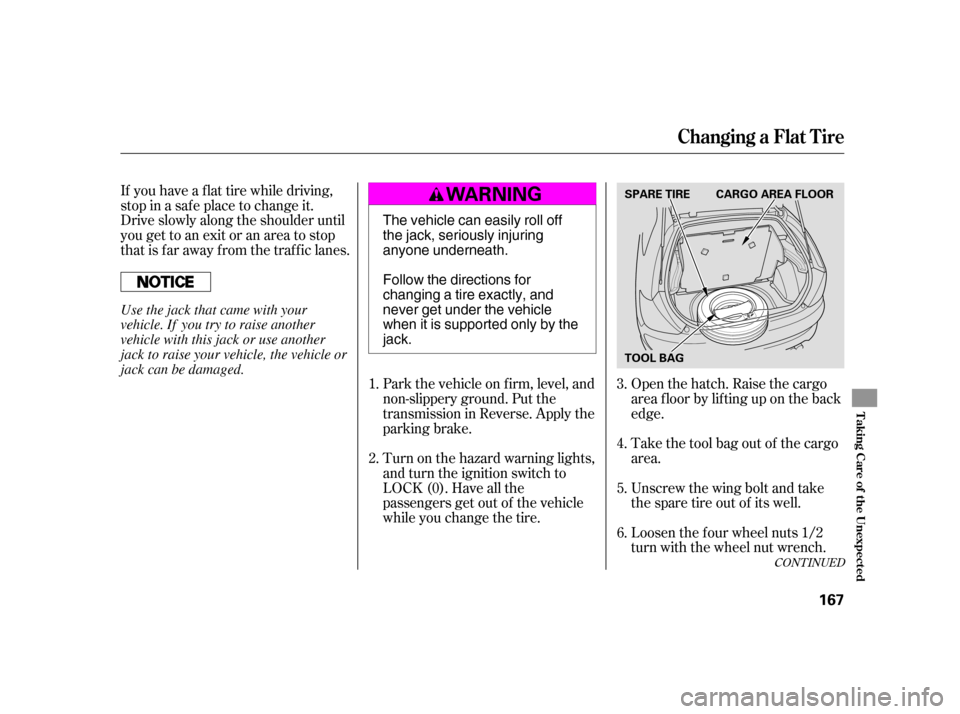Page 142 of 205
Push the bulb holder into the light
assembly until it locks in place.
Testthelightstomakesurethe
new bulb is working.
Line up the clips on the interior
trim with the corresponding holes
in the hatch.Push on the trim to
snap it back in place.Pushthefrontof thesideturn
signal assembly toward the rear of
the vehicle until it pops out of the
body.
Turn the socket one-quarter turn
counterclockwise to remove it
from the lens.Pull the bulb straight out of its
socket. Push the new bulb straight
into the socket until it bottoms.
Put the socket back into its hole in
the lens and turn it clockwise until
it locks.
Testthelightstomakesurethe
new bulb is working.
Put the side turn signal assembly
back into the body, rear first. Push
on the f ront edge until it snaps into
place.
1.
2. 3. 5. 6.
4.
6.7.
5.
Lights
Replacing a Side T urn Signal Bulb
Maint enance
151
BULB
SOCKET
�����—�����—�
���y�
������
������y���
�(���)�������y���
�����y
Page 145 of 205
To replace a f ront wiper blade:Raise the wiper arm of f the
windshield. Raise the driver’s side
first, then the passenger’s side. Disconnect the blade assembly
fromthewiperarmbypushingin
the lock tab. Hold the lock tab in
while you push the blade assembly
toward the base of the arm.
Check the condition of the wiper
blades at least every 6 months.
Replace them if you f ind signs of
cracking in the rubber, areas that are
getting hard, or if they leave streaks
and unwiped areas when used.
2.
1.
Wiper Blades
154 WIPER ARMS
LOCK TAB
�����—�����—�
���y�
������
������y���
�(���)�������y���
�����y
Page 146 of 205
Remove the blade f rom its holder
by grasping the tabbed end of the
blade. Pull f irmly until the tabs
come out of the holder.Examine the new wiper blades. If
they have no plastic or metal
reinf orcement along the back
edge, remove the metal
reinf orcement strips f rom the old
wiper blade, and install them in
the slots along the edge of the new
blade.Slide the new wiper blade into the
holder until the tabs lock.
Slide the wiper blade assembly
onto the wiper arm. Make sure it
locks in place.
Lower the wiper arm down against
the windshield. Lower the
passenger’s side f irst, then the
driver’s side.
3. 4. 5. 6. 7.
CONT INUED
Wiper Blades
Maint enance
155
BLADE
BLADE
REINFORCEMENT
�����—�����—�
���y�
�������������y���
�(���)�������y���
�����y
Page 154 of 205

If you need to park your vehicle f or
an extended period (more than one
month), there are several things you
should do to prepare it f or storage.
Proper preparation helps prevent
deterioration and makes it easier to
get your vehicle back on the road. If
possible, store your vehicle indoors.Fill the f uel tank.
Change the engine oil and f ilter. Block the rear wheels.
If the vehicle is to be stored f or a
longer period, it should be
supported on jackstands so the
tires are of f the ground.
Leave one window open slightly (if
the vehicle is being stored
indoors).
Cover the vehicle with a
‘‘breathable’’ cover, one made
f rom a porous material such as
cotton. Non-porous materials, such
as plastic sheeting, trap moisture,
which can damage the paint.
Wash and dry the exterior
completely.
Cleantheinterior.Makesurethe
carpeting, floor mats, etc., are
completely dry.
Leave the parking brake off. Put
the transmission in Reverse. Support the f ront and rear wiper
blade arms with a f olded towel or
ragsotheydonottouchthe
windshield.
Disconnect the battery.
To minimize sticking, apply a
silicone spray lubricant to all door
and hatch seals. Also, apply a
vehiclebodywaxtothepainted
surfaces that mate with the door
and hatch seals. If you store your vehicle f or 12
months or longer, have your dealer
perf orm the inspections called f or in
the 24 months/30,000 miles
(48,000 km) maintenance schedule
(Normal Conditions) as soon as you
take it out of storage (see page ).
The replacements called f or in the
maintenance schedule are not
needed unless the vehicle has
actually reached that time or mileage.If possible, periodically run the
engine until it reaches f ull
operating temperature (the
cooling f an cycles twice).
Pref erably, do this once a month.
133
Vehicle Storage
Maint enance
163
�����—�����—�
���y�
�������������y���
�(���)�������y���
�����y
Page 157 of 205

CONT INUED
If you have a f lat tire while driving,
stop in a saf e place to change it.
Drive slowly along the shoulder until
you get to an exit or an area to stop
that is far away from the traffic lanes.Park the vehicle on f irm, level, and
non-slippery ground. Put the
transmission in Reverse. Apply the
parking brake.
Turn on the hazard warning lights,
and turn the ignition switch to
LOCK (0). Have all the
passengers get out of the vehicle
while you change the tire.Open the hatch. Raise the cargo
area floor by lifting up on the back
edge.
Take the tool bag out of the cargo
area.
Unscrew the wing bolt and take
the spare tire out of its well.
Loosen the f our wheel nuts 1/2
turn with the wheel nut wrench.
2.
3.
1.
4. 5.6.
Changing a Flat T ire
T aking Care of t he Unexpect ed
167
SPARE TIRE CARGO AREA FLOOR
TOOL BAG
The vehicle can easily roll off
the jack, seriously injuring
anyone underneath.
Follow the directions for
changing a tire exactly, and
never get under the vehicle
when it is supported only by thejack.
Use the jack that came with your
vehicle. If you try to raise another
vehicle with this jack or use another
jack to raise your vehicle, the vehicle or
jack can be damaged.
�����—�����—�
���y�
���������
���y���
�(���)�������y���
�����y
Page 158 of 205
Place the jack under the jacking
point. Turn the end bracket
clockwise until the top of the jack
contacts the jacking point. Make
sure the jacking point tab is
restinginthejacknotch.Use the extension and the wheel
nut wrench as shown to raise the
vehicle until the f lat tire is of f the
ground.
Bef ore mounting the spare tire,
wipeanydirtoff themounting
surface of the wheel and hub with
a clean cloth. Wipe the hub
carefully;itmaybehotfrom
driving.
Put on the spare tire. Put the
wheel nuts back on f inger-tight,
then tighten them in a crisscross
pattern with the wheel nut wrench
until the wheel is f irmly against
the hub. Do not try to tighten
them f ully.
Remove the wheel nuts, then
remove the flat tire. Place the flat
tire on the ground with the outside
surface facing up.
7.
8. 9.10.
11.
Changing a Flat T ire
168 JACKING POINT
WHEEL
WRENCH
EXTENSION BRAKE HUB
�����—�����—�
���y�
�������������y���
�(���)�������y���
���
�y
Page 161 of 205

You hear nothing, or almost
nothing. The engine’s starter
motor does not operate at all, or
operates very slowly.
You can hear the starter motor
operating normally, or the starter
motor sounds like it is spinning
f aster than normal, but the engine
does not start up and run.When you turn the ignition switch to
START (III), you do not hear the
normal noise of the engine trying to
start. You may hear a clicking sound
or series of clicks, or nothing at all.
Turn the ignition switch to START
(III). If the headlights do not dim,
check the condition of the f uses. If
thefusesareOK,thereis
probably something wrong with
the electrical circuit f or the
ignition switch or starter motor.
You will need a qualif ied
technician to determine the
problem (see
on page ).
If the headlights dim noticeably or
go out when you try to start the
engine, either the battery is dis-
charged or the connections are
corroded. Check the condition of
the battery and terminal connec-
tions (see page ). You can
then try jump starting the vehicle
f rom a booster battery (see page
).
Turn the ignition switch to ON (II).
Turn on the headlights, and check
their brightness. If the headlights
areverydimordonotcomeonat
all, the battery is discharged. See
on page .
Check the transmission interlock.
The clutch pedal must be pushed
all the way to the f loor or the
starter will not operate.
Check these things:
Diagnosing why the engine won’t
start f alls into two areas, depending
on what you hear when you turn the
key to START (III):
173162
173 186
Nothing Happens or the Starter
Motor Operates Very Slowly
Emergency T owing
Jump Starting
If theEngineWon’tStart
T aking Care of t he Unexpect ed
171
�����—�����—�
���y�
�������������y���
�(���)�������y���
�����y
Page 166 of 205

Using gloves or a large heavy
cloth, turn the radiator cap
counterclockwise, without pushing
down, to the f irst stop. Af ter the
pressure releases, push down on
the cap, and turn it until it comes
off.Put the radiator cap back on
tightly. Run the engine, and watch
the temperature gauge. If it goes
back to the red mark, the engine
needs repair (see
on page ).
If the temperature stays normal,
check the coolant level in the
radiator reserve tank. If it has
gone down, add coolant to the
MAX mark. Put the cap back on
tightly.
If there was no coolant in the
reserve tank, you may need to add
coolant to the radiator. Let the
engine cool down until the pointer
reaches the middle of the
temperature gauge or lower
bef ore checking the radiator.
Start the engine, and set the
temperature control dial to
maximum heat. Add coolant to the
radiator up to the base of the f iller
neck. If you do not have the
proper coolant mixture available,
you can add plain water.
Remember to have the cooling
system drained and ref illed with
the proper mixture as soon as you
can.
8. 9.
10. 11.
7.
186Emergency
Towing
If theEngineOverheats
176 Removing the radiator cap
while the engine is hot can
cause the coolant to spray out,
seriously scalding you.
Always let the engine and
radiator cool down before
removing the radiator cap.
�����—�����—�
���y�
�������������y���
�(���)�������y���
�����y